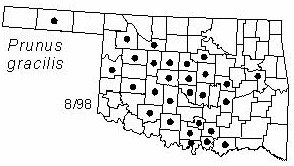Shrub to 1.5 m (5 ft) tall, often forming dense thickets. Crown irregular. Bark red-brown to dark gray with thin scales, prominent lenticels. Twigs red-brown, turning gray with age, pubescent when young, becoming glabrous with age. Leaves alternate, simple, elliptic, oval or ovate, 2.5-5 cm (1-2 in) long; with reticulate venation beneath, glabrous to slightly pubescent above, densely pubescent beneath; gradually narrowed at base, acute or obtuse at apex, margins sharply serrate with appressed teeth; petiole short, pubescent and glandless. Flowers in umbels, pubescent, with 2-4 flowers 6-8 mm (0.25-0.35 in) in diameter; petals 5, white; styles 1; stamens numerous; flowers appear in March, before the leaves open. Fruits drupes, about 15 mm (0.6 in) in diameter, subglobose, red; fruits mature June to August.
Distribution: Oklahoma, Kansas, Tennessee, Arkansas and north Texas. Common.
Habitat: sandy soil. Fencerows and thickets.
NWI status: none
Comments: Prunus is the classical name for European plums; gracilis refers to slender branches.
Horticulture: Easily grown from seed or transplant. Introduced into cultivation in 1916, primarily for the fruit. Oklahoma plum suffers from black knot, however.
Food uses: The fruits can be eaten raw or cooked. They are often prepared as jelly or preserves. Native Americans sun dried the plums for winter consumption, but not all tribes removed the pits first.
Wildlife benefits: The fruits of Oklahoma plum are eaten by several species of birds and mammals. The dense thickets also provide cover.
Distribution in Oklahoma: 
BACK
NEXT
RETURN TO INDEX
Last update: 9/15/99
 Go to Oklahoma Biological Survey Home Page
Go to Oklahoma Biological Survey Home Page
 Disclaimer
Disclaimer